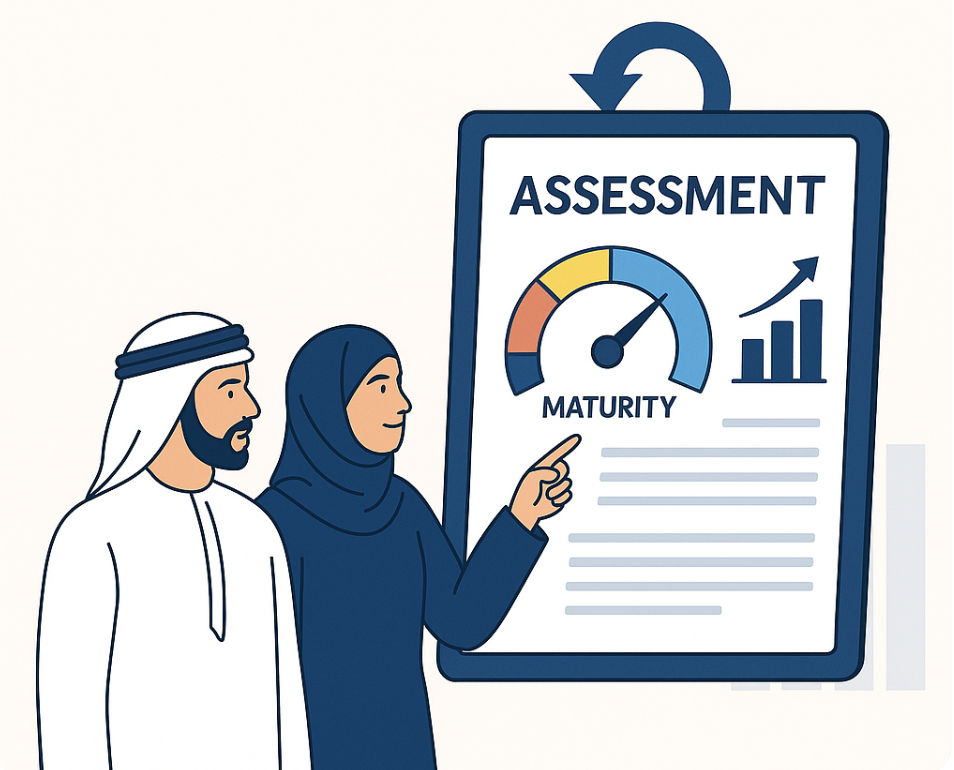In the dynamic landscape of modern business, Agile frameworks have become the cornerstone of innovation and efficiency. The Gulf Cooperation Council (GCC) region, encompassing countries such as the UAE, Saudi Arabia, and Qatar, is witnessing a growing interest in Agile practices. This surge is driven by the need for organisations to remain competitive, responsive, and adaptable. However, a significant challenge lies in bridging the gap between academic Agile training and its practical application in the real world. This article explores the nuances of this transition, particularly within the context of the GCC market, and offers strategies to ensure successful Agile implementation.
The Academic Foundation of Agile
Academic training in Agile, provides a robust foundation. Universities and training institutes in the GCC region are increasingly incorporating Agile courses into their curricula. These courses cover essential frameworks such as Scrum, Kanban, and Lean, focusing on principles, roles, and processes.
Harrisburg University, a notable institution known for its focus on science and technology, also provides an exemplary model of how Agile training can be structured. The university offers comprehensive Agile courses that cover both theoretical foundations and practical applications, preparing students for real-world challenges. Their curriculum includes detailed studies on Agile frameworks and provides hands-on experiences through projects and internships. This blend of academic rigour and practical experience is essential for producing graduates who are ready to implement Agile frameworks effectively.
While academic programs are comprehensive, they often focus on theoretical knowledge. Students learn about Agile events, artefacts, and roles/accountabilities, but the controlled environment of a classroom can’t fully replicate the complexities and unpredictability of real-world projects. This gap between theory and practice can pose challenges when students enter the workforce.
Challenges in Transitioning from Theory to Practice
1. Cultural and Organisational Resistance:
- Issue: Traditional hierarchical structures prevalent in many GCC organisations can resist the flat and collaborative nature of Agile.
- Solution: Leadership training is crucial. Agile champions within organisations should be identified and trained to promote Agile values and principles.
2. Lack of Practical Experience:
- Issue: Graduates may lack hands-on experience, making it difficult for them to navigate real-world complexities.
- Solution: Internships and cooperative education programs can bridge this gap. Partnering with businesses to provide students with real project experience is invaluable. For example, Harrisburg University collaborates with industries to offer internships that allow students to apply Agile practices in real projects, providing them with invaluable experience before they graduate.
3. Understanding of Agile Beyond IT:
- Issue: Agile is often perceived as an IT-centric methodology, while its principles are applicable across various functions.
- Solution: Broader education on Agile applications in marketing, HR, and operations can help integrate Agile into the organisational culture.
4. Tool Proficiency:
- Issue: Proficiency with Agile tools such as JIRA, Trello, and Confluence is often not covered in depth in academic settings.
- Solution: Training programs should include hands-on sessions with these tools. Certification courses can also ensure students are well-versed in industry-standard tools.
Case Study: Agile Implementation in a GCC Organisation
Company X: A leading financial services provider in the UAE embarked on an Agile transformation to enhance its product delivery and customer satisfaction. Despite comprehensive training, the initial implementation faced significant hurdles.
- Challenge: Teams struggled with the shift from a traditional waterfall model to Agile, facing resistance from middle management.
- Approach: The company initiated a phased implementation. They began with pilot projects in non-critical areas, allowing teams to gain confidence and demonstrate the benefits of Agile practices.
- Outcome: Over six months, the pilot projects delivered successful outcomes, including a 20% reduction in time-to-market and improved team morale. The success of these projects convinced sceptical managers to support a broader Agile rollout.
This case study highlights the importance of a strategic approach to Agile implementation, addressing both technical and cultural aspects.
Strategies for Successful Agile Implementation
1. Customised Training Programs:
- Approach: Tailor training programs to the specific needs of the organisation. Incorporate real-life scenarios and problem-solving exercises that reflect the company's projects.
- Benefit: Enhances relevance and retention of knowledge, making it easier for teams to apply what they've learned.
2. Mentorship and Coaching:
- Approach: Engage experienced Agile coaches to mentor teams. Coaches can provide on-the-job guidance, helping teams navigate challenges and refine their Agile practices.
- Benefit: Accelerates the learning curve and builds confidence within teams.
3. Incremental Implementation:
- Approach: Start with small, manageable projects to pilot Agile practices. Use the lessons learned to refine the approach before scaling up.
- Benefit: Reduces risk and builds a track record of success, which can help in gaining broader organisational buy-in.
4. Continuous Learning and Improvement:
- Approach: Encourage a culture of continuous improvement. Regular retrospectives should be held to reflect on what is working and what isn’t, making necessary adjustments.
- Benefit: Ensures that Agile practices evolve and improve over time, adapting to the changing needs of the organisation.
5. Cross-functional Teams:
- Approach: Form cross-functional teams that include members from various departments. This helps in breaking down silos and promotes a more holistic approach to problem-solving.
- Benefit: Enhances collaboration and ensures that different perspectives are considered, leading to better outcomes.
The Role of Leadership in Agile Transformation
Leadership plays a pivotal role in the success of Agile transformations. In the GCC region, where hierarchical organisational structures are common, leaders must actively champion Agile principles.
- Vision and Commitment: Leaders should articulate a clear vision for Agile adoption, demonstrating their commitment through actions and decisions.
- Empowerment: Empower teams to make decisions and take ownership of their work. This shift from command-and-control to servant leadership is crucial for Agile success.
- Continuous Engagement: Leaders should remain engaged with Agile teams, participating in key ceremonies like Sprint Reviews and Retrospectives. Their involvement signals the importance of Agile practices and fosters a culture of accountability.
Building an Agile Culture
Creating an Agile culture is as important as implementing Agile processes. This cultural shift involves:
- Values and Principles: Embedding Agile values such as transparency, collaboration, and customer-centricity into the organisational DNA.
- Recognition and Rewards: Recognising and rewarding behaviours that align with Agile principles. This reinforces the desired cultural change.
- Learning and Development: Providing continuous learning opportunities for employees at all levels. This can include workshops, seminars, and access to online resources.
Agile Transformation in the GCC: Unique Considerations
The GCC region presents unique opportunities and challenges for Agile adoption:
1. Economic Diversification:
- Context: GCC countries are diversifying their economies away from oil dependence. Agile practices can drive innovation in sectors such as finance, healthcare, and technology.
- Example: Saudi Vision 2030 aims to develop public service sectors such as health, education, infrastructure, recreation, and tourism. Agile practices can accelerate project delivery in these areas.
2. Cultural Factors:
- Context: The GCC’s cultural context, with its emphasis on hierarchy and respect for authority, can impact Agile adoption.
- Approach: Agile transformations should be sensitive to cultural nuances. Training programs can emphasise how Agile principles of respect and collaboration align with cultural values.
3. Regulatory Environment:
- Context: The regulatory environment in GCC countries can influence Agile implementation, particularly in heavily regulated sectors like finance and healthcare.
- Solution: Agile practices can be tailored to ensure compliance with local regulations, such as incorporating compliance reviews into the Sprint cycle.
4. Infrastructure and Technology:
- Context: The GCC region boasts advanced technological infrastructure, providing a conducive environment for Agile adoption.
- Example: The UAE’s Smart Dubai initiative aims to transform Dubai into the world’s smartest city. Agile frameworks can support the rapid development and deployment of smart city solutions.
Conclusion
Bridging the gap between academic Agile training and real-world implementation is a multifaceted challenge, particularly in the GCC region with its unique cultural and organisational landscapes. However, with strategic planning, customised training, and strong leadership, organisations can successfully navigate this transition. By fostering a culture of continuous improvement and embracing Agile principles, GCC businesses can enhance their competitiveness and responsiveness, ensuring long-term success in an ever-evolving market.
Harrisburg University, with its blend of academic rigor and practical experience, serves as an excellent model for how Agile training can be structured to prepare students for the real world. By incorporating hands-on projects and internships, the university ensures that its graduates are well-equipped to bridge the gap between theory and practice.
Agile Arabia, with its expertise and tailored approach, stands as a pivotal partner for organisations in the GCC, guiding them through the complexities of Agile transformation and helping them realise the full potential of Agile methodologies. The journey from academic theory to practical implementation may be challenging, but with the right strategies and support, it can lead to transformative outcomes for organisations across the GCC.
Talk to us today if you’re looking for support with Training, Coaching or Consultancy on your Agile Transformation journey.




